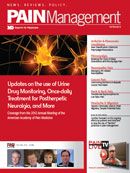A Variety of Factors Contribute to the Undertreatment of Cancer Pain
Observers have repeatedly identified several barriers to adequate cancer pain relief and suggested areas for improvement, yet studies continue to reveal that cancer pain is often undertreated.
The inadequate pain treatment received by patients with cancer has been an ongoing concern among the oncology and pain management communities for many years. An editorial published in 1993 in Supportive Care in Cancer stated that oncology professionals “need to learn how to assess pain, to use analgesic therapies appropriately, and to change their attitudes and misconceptions about the chronic use of opioid drugs… they need to prioritize pain assessment and treatment and empower patients to do the same” (http://bit. ly/z8UiBl).
A review article on the barriers and remedies to the undertreatment of cancer pain published in the same issue concluded that “Patients frequently do not communicate the intensity of their pain to care-givers and are often hesitant to take opiates. Health-care providers receive scant teaching on cancer pain, have little awareness of pain intensity in their patients, and may be overly concerned about opiate toxicities” (http://bit.ly/w4jl9y).
James F. Cleary, MD, FRCAP, FAChPM
Director, Pain & Policy Studies Group Director of the Palliative Care Program at the University of Wisconsin Hospital and Clinics
“These studies show that after 20 years, we have made little progress in the treatment of cancer pain. Despite considerable efforts to improve cancer pain relief, many oncologists will not appropriately prescribe opioids. Older minority women were most likely to be undertreated in 1996, and this trend continues today. Pain management physicians have both an opportunity and an obligation to ensure access to appropriate medications, including opioids, by working closely with oncologists and the rest of the care team.”
Many of these same factors have been repeatedly identified over the years as contributing to the undertreatment of cancer pain across patient populations and clinical settings. The authors of a study published in The Journal of Pediatric Hematology and Oncology (http://bit.ly/AgCjF2) reported that “many parents of children with cancer have misconceptions regarding issues of pain management” (especially regarding analgesic use and children’s’ experience of pain) that can potentially lead to undertreatment of pain in children. Elderly patients suffering with cancer-related pain also experience inadequate analgesia, with one recent study (http://bit. ly/yzFmax) revealing that nearly one-third of patients who reported experiencing severe pain had not filled a prescription for opioid medications. The authors speculated that a range of familiar patient- and provider-related factors contributed to the discrepancy. These themes were further reinforced by a study, published in The Clinical Journal of Pain (http://bit.ly/xWv59M), that surveyed more than 1,100 patients with cancer, two-thirds of whom reported experiencing pain from either their disease or treatment. One-quarter of surveyed patients did not use analgesics. The authors reported that patients’ reasons for not taking analgesics included: health care provider did not recommend these medications (85%), fear of addiction and/or dependence (80%), and inability to pay (76%).
Factors contributing to undertreatment of cancer pain:
- Patient reluctance to take opioids, due to fears and misconceptions regarding relative risks and benefits of opioid pain medications (especially with regard to addiction risks)
- Inadequate training in pain management received by oncologists
- Patient tendency to underreport pain/ reluctance to disclose pain
- Incomplete/inadequate pain assessment by treating clinicians
- Lack of involvement of pain specialists and/or palliative care specialists
- Poor communication between primary care physicians and the cancer care team
- Medication cost and/or inadequate insurance
A Journal of Clinical Oncology article (http://jco.ascopubs.org/content/29/36/4769.abstract) published late last year reported that surveyed oncologists tended to rate rather highly their own abilities to manage cancer pain, while viewing their peers as too conservative in their approaches to pain management. This despite giving poor ratings to the quality of pain management training they received during medical school and residency, rarely referring patients to pain or palliative care specialists, and, in response to questions outlining hypothetical clinical scenarios, prescribing treatments “that would be considered unacceptable by pain specialists.” Barriers to pain management identified by oncologists included poor assessment, patient reluctance to take opioids or report pain, physician reluctance to prescribe opioids, and “perceived excessive regulation” of opioid prescribing. An editorial accompanying publication of this article noted that the results of this survey (which was modeled on a similar survey administered 20 years previously) indicate that “oncologists’ attitudes and practice in cancer pain management have changed surprisingly little over the last two decades,” despite the fact that “multiple excellent education programs in pain management and palliative cancer care have been developed” over the past decade (http://bit.ly/Ap0wNy).
